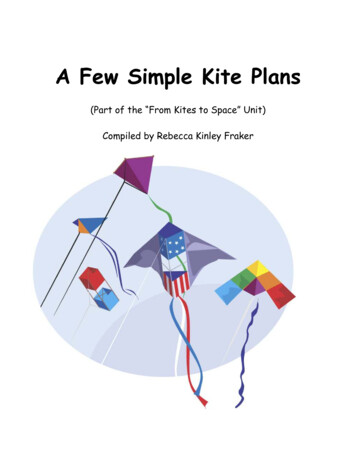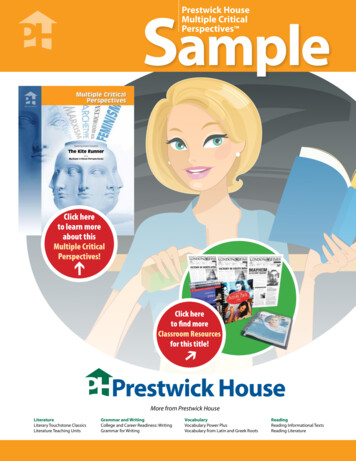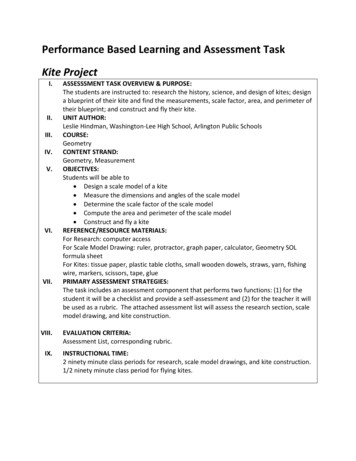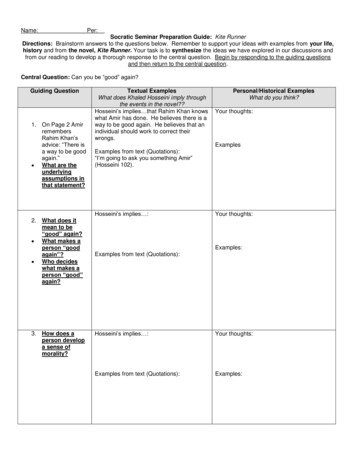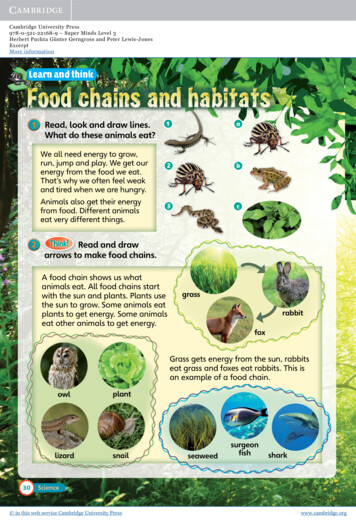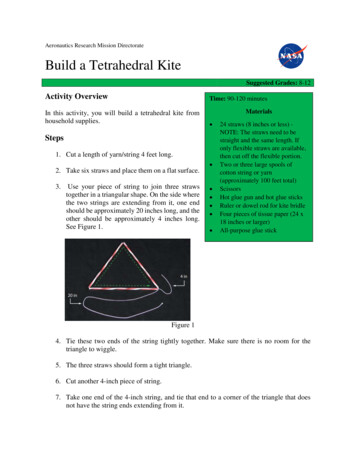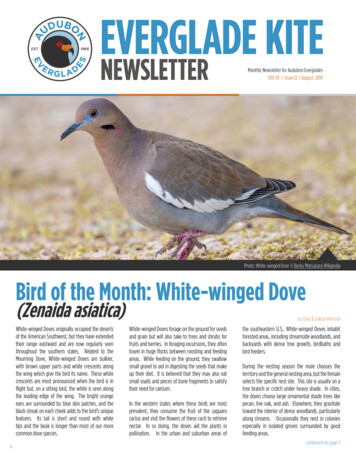
Transcription
EVERGLADE KITENEWSLETTERMonthly Newsletter for Audubon EvergladesVOL 59 Issue 12 August 2019Photo: White-winged Dove Becky Matsubara WikipediaBird of the Month: White-winged Dove(Zenaida asiatica)White-winged Doves originally occupied the desertsof the American Southwest, but they have extendedtheir range eastward and are now regularly seenthroughout the southern states. Related to theMourning Dove, White-winged Doves are bulkier,with brown upper parts and white crescents alongthe wing which give the bird its name. These whitecrescents are most pronounced when the bird is inflight but, on a sitting bird, the white is seen alongthe leading edge of the wing. The bright orangeeyes are surrounded by blue skin patches, and theblack streak on each cheek adds to the bird’s uniquefeatures. Its tail is short and round with whitetips and the beak is longer than most of our morecommon dove species.1by Clive & Celecia PinnockWhite-winged Doves forage on the ground for seedsand grain but will also take to trees and shrubs forfruits and berries. In foraging excursions, they oftentravel in huge flocks between roosting and feedingareas. While feeding on the ground, they swallowsmall gravel to aid in digesting the seeds that makeup their diet. It is believed that they may also eatsmall snails and pieces of bone fragments to satisfytheir need for calcium.In the western states where these birds are mostprevalent, they consume the fruit of the saguarocactus and visit the flowers of these cacti to retrievenectar. In so doing, the doves aid the plants inpollination. In the urban and suburban areas ofthe southeastern U.S., White-winged Doves inhabitforested areas, including streamside woodlands, andbackyards with dense tree growth, birdbaths andbird feeders.During the nesting season the male chooses theterritory and the general nesting area, but the femaleselects the specific nest site. This site is usually on atree branch or crotch under heavy shade. In cities,the doves choose large ornamental shade trees likepecan, live oak, and ash. Elsewhere, they gravitatetoward the interior of dense woodlands, particularlyalong streams. Occasionally they nest in coloniesespecially in isolated groves surrounded by goodfeeding areas.continued on page 3
UPCOMING TRIPSAUGUST 201910 SAT & 17 SAT Duda FarmsSpecial Trip for Friends of Audubon EvergladesRegistration required.CURRENTVOLUNTEEROPPORTUNITIESby Susan McKemyYOU CAN MAKE A DIFFERENCEVOLUNTEER WITH AUDUBON EVERGLADESDo you have some free time to share? Would you like toget more involved with Audubon Everglades? We haveplenty of volunteer opportunities and are sure to have aplace where you can make a difference. Remember, YOUare what hope looks like to a bird - get involved!If you have a special interest or talent or simply want togive back to Audubon Everglades as a volunteer, pleasecheck the list of volunteer opportunities. If your interestarea is not listed but you would like to volunteer, get intouch with us and let us know your interest. There arenew ways to get involved all the time.If you would like more information or are ready toget involved, please send an email to President@AudubonEverglades.org. We look forward to havingyou on our team!CURRENT OPPORTUNITIESCommunity Science Projects(bird surveys, habitat projects, etc.)Community EventsConservation Advocacy TeamEducation and OutreachSocial MediaVolunteer Organizer2Audubon EvergladesFriends Photos and IceCream SocialAUG06by Mary DunningTuesday, August 6 at 6:30PMMeeting is free and open to the public. Doors open at 6:30PM. Rooms 101 and 102 at FAUPine Jog Environmental Education Center, 6301 Summit Blvd (near Jog Road) in West PalmBeach. We look forward to seeing you there!We are serving up a sweet program this month thatis sure to bring you relief from the heat. Join usAugust 6 for our Ice Cream Social and enjoy a coolice cream sundae while you view a picture show ofimages created by our Friends members.Audubon Everglades has some extremely talentedmembers who have put together images of theirbest bird and nature photography. Members willspeak about their photos as they are presented. Wealways enjoy hearing the background story on whatit took to get the shot.Also on the program - August Bird of the Month:White-winged Dove. Come hear more about thisbackyard bird from our expert, Clive Pinnock.Help us make this fun evening green.We encourage you to bring your own bowl and spoon.We’ll supply the ice cream and sprinkles!September’s Monthly Meeting will be held Tuesday, September 3 at 7PM at OriginChurch, 6073 Summit Blvd. The speaker will be LTC Jennifer Reynolds, DeputyCommander for South Florida, US Army Corp of Engineers, presenting “LakeOkeechobee -Balancing competing demands of water needs, safety of the dike,and discharges from the lake”
Profile: Linda McCandlessby Kristen MurtaughPhoto: Linda McCandless at Yellowstone National Park,June 2019Linda McCandless is a Florida native who has neverlived in any state other than Florida. She was bornin Ocala and grew up in the Ocala National Forest.She graduated from the University of Central Florida(Florida Technological University then) in 1972 with aBS in Computer Science.Linda worked from 1972 – 2015 as a softwareengineer at the Florida divisions of WestinghouseElectric Corporation, ITT North Electric, StrombergCarlson, and Siemens Corporation. She had severalbusiness trips to Latin America and Europe. A lengthytrip to Munich introduced her to sleet, somethingthis Florida native had never experienced before.During the 1980s Linda tried out various sports. Shetook up snow skiing, earned a private pilot’s license,and became a certified scuba diver. None of thesepastimes quite fit in the long run. This was BB (seebelow).In March 1993, Linda took a sightseeing trip toAlaska. There was a couple on the tour: she wasinto plants and flowers and always looking down;he was into birds and always looking up. They werehaving dinner on the boat one evening, when thenaturalists excitedly called out a bird species overthe speaker system so the gentleman could go look.Really excited, he ran out of the dining room to seethe bird. Linda remembers thinking, “Birders are avery strange lot!” But now she wonders what birdshe missed!In 1995 she moved to her house on a small canal in westBoca Raton. One day in the late 1990s, she noticed3wave after wave of wading birds working their waydown the canal. At the time, she didn’t know a heronfrom an egret. She decided she wanted to know, soshe started participating in the Loxahatchee NationalWildlife Refuge bird walks on Saturday mornings.Linda intended to go only as many times as it tookto learn the wading bird names, but the enthusiasmof the walk leaders - Pat Canning and Ruth Baker rubbed off on her. She joined the walks almost everyweek, bought a National Geographic Field Guide, andstarted recording the date/location of each new birdshe saw. Mostly the same people would come onthe walks, and one morning Linda noticed someonemissing. One of the leaders said, “Oh, she probablywent to a different park to go birding.” A newconcept for Linda: she could go to other parks to lookat birds! She started branching out, first locally, toSpanish River Park and Wakodahatchee, then furtherafield, to Hugh Taylor Birch, Merritt Island, and DudaFarms. She participated in field trips sponsored byMiami’s Tropical Audubon Society to the Evergladesand Bill Baggs Cape Florida State Park.Linda’s first birding trip outside of Florida was toSoutheast Arizona in July 2001, where she saw scoresof life birds. By now she was hooked on birding andbegan traveling, almost every year, and sometimestwice a year, to locations which would allow her tosee new birds. Her many birding trips have takenher to the Dry Tortugas, Ft. DeSoto, north Florida,the Bahamas, New England, North Carolina, Texas,Colorado, California, the Pacific Northwest, Alaska,Wyoming and Montana, Illinois and Michigan,North Dakota and Minnesota. And not just once,but multiple times to some of these hot spots. Thelists of the species highlights of these trips woulddouble the space of this profile. The bird list thatLinda started in February 2000 at Loxahatchee haslengthened considerably! She went to Minnesotathis past February (The frigid temperatures didn’tkeep this Florida native from chasing and findingspecial species such as the Northern Hawk Owl!). Thissummer she spent 10 wonderful days in YellowstoneNational Park with two other birders.Twenty years ago, Linda joined a Boca RatonAudubon chapter. When that chapter disbanded,she became a member of Audubon Everglades. Shehas been an Audubon Everglades board memberat-large since July 2015. Through Audubon, Linda isproud to have participated in several citizen scienceprojects related to birds, such as the Christmas BirdCount, EagleWatch, Project Perch, and the Lake WorthLagoon bird survey, and, through them, feels thatshe is helping to save our birds. Linda leads walksat Spanish River Park for Audubon Everglades andsends out the email reminders of the chapter fieldtrips.Linda says her life can be split into two phases: BB(before birding) and AB (after birding). She is gratefulto Pat and Ruth for getting her hooked on birdwatching twenty years ago. It helps her connect withnature, and it’s good for her health. Some peoplestruggle to find things to do in retirement; she hasnever had that issue: she just grabs her binocularsand goes birding or plans a birding trip. For Linda,though, the best part about birding is that it’s a greatway to make friends. She’s developed what will belifelong friendships with people she’s met birding,both locally and nationally.Linda is also interested in native plants. Her yard issmall, but it’s filled with natives. She is an enthusiasticsupporter of the National Audubon “Plants for Birds”program and enjoys going on the annual Native PlantSociety garden tour.Last, but hardly least, is her dog, Charlie, a sweetrescue mixed breed she adopted from the BrowardHumane Society. He’s lived with Linda for seven yearsand brings her joy every day.White-winged Dove continued from page 1During courtship both members of the pair gothrough ritualized nodding and preening motions.Once the pair-bond is established, a flimsy nestconstructed of various materials (sticks, weeds,grasses, pine needles, Spanish moss and feathers)is built anywhere from 4 to 30 feet off the ground.The male brings most of the material and the femalebuilds the nest. Both adults incubate the 1- 4 palebuff eggs for 13-14 days. At hatching, the youngare fed “pigeon milk” or “crop milk,” a curd-likesubstance that is secreted from fat-filled cells thatline the parent crop and regurgitated to feed thehatchlings. The young leave the nest at about 1316 days and are fed by both parents for some timeafterwards.
CORRECTIONS TO JULY’S INSPIRATIONAL EAGLE STORY BYLINDA MCCANDLESS AND DOREEN LEPAGEIn the July issue of the Kite, the authors and portionsof the article “Local Good Samaritan Saves InjuredBald Eagle” were inadvertently omitted. Apologiesto Linda McCandless and Doreen LePage who coauthored the inspirational article. We hope you enjoyreading this happy ending and consider gettinginvolved with EagleWatch.LOCAL GOOD SAMARITAN SAVES INJURED BALD EAGLE(Continued from the July 2019 Kite)So, on May 31, Lou and Linda drove Liesel and asecond immature Bald Eagle named Glory from theBusch Wildlife Sanctuary up to the Audubon Centerfor Birds of Prey (CBOP) in Maitland. Liesel and Glorywere each confined in their own appliance-sized boxfor the drive. Upon arriving, they were weighed andgiven an initial health exam. After a short stay in thebird mews, Liesel transitioned to the CBOP large flightbarn, where within two weeks she proved she wasready to be released.To become a Bald Eagle Good Samaritan like Lou,please see: Be an EagleWatcherCBOP flight barn webcam.Busch Wildlife Sanctuary website.Shawnlei examined the EagleWatch database anddetermined a release site which met these criteria:the nest was in an accessible and safe area and thearea was open enough to give the fledgling room totake off.On the morning of June 12, Liesel was banded witha federally regulated metal band imprinted with aunique 9-digit number to identify her and releasedin an Orlando area neighborhood which has a nearbyeagle’s nest with two juvenile eagles. Highlights forLou were that he was allowed to hold her in the car asthe team drove to the release site and he was the onewho released her!Photo: Lou Ulrey with K28 EagleTHE BIRD NERD: AND NOW FORSOMETHING DIFFERENTby Bob DieterichIn this time of doldrums, before the fall migration starts, I thought it might be fun to inject a little levity. See the little bird quiz below that I came up with in a moment of idlecontemplation.Some bird names just don’t seem to do proper justice in the description department. Try to match the scrambled alternate names in the left column with the accepted commonnames of familiar birds in the right column. Answers appear on page 5.1. Harlequin Sandpiper2. Sooty Falcon3. Orange-crowned Warbler (really)4. Greater Peep5. Black-winged Redbird6. Masked Fruiteater7. Black-bellied Sandpiper8. Warbling Thrush9. White-winged Nightjar10. Greater Yellowthroat4a. Pectoral Sandpiperb. Cedar Waxwingc. Common Nighthawkd. American Robine. Ruddy Turnstonef. Yellow-breasted Chatg. Ovenbirdh. Scarlet Tanageri. Merlinj. Dunlin
HAS THE SPIRIT OF TEDDY ROOSEVELT ALREADYLEFT THE FLORIDA GOVERNOR’S MANSION?by Scott ZuckerDuring the past few years, Floridians have seen theirstate imperiled by catastrophic Hurricanes Irma andMichael, their waters polluted by blue-green algaeand red tide, their beaches littered with plasticdebris, their wild places threatened by fracking anddevelopment, their hope for Everglades restorationstalled, and their coastal areas endangered by sealevel rise and the threat of offshore drilling.Promoting himself as a “Teddy RooseveltConservationist,” Ron DeSantis narrowly won the 2018election for Governor of Florida over Democrat AndrewGillum, promising to prioritize “environmental issues,like water quality and cleaning the environmentalmess that has resulted in toxic blue-green algae andexacerbated red tide around the state.”To his credit he has tried to make good on thosepromises. But, in his first year as Governor, he has alsosigned a number of bills into law that will have farreaching negative consequences for the environment.This year’s funding for Everglades restoration andcleaning up the environment was a 2.4 billionincrease over last year’s total, but 200 million lessthan the Governor had promised in January. Thefunding includes 682 million for Lake Okeechobeeand Everglades restoration and improving waterquality and Florida’s springs, underscoring how, atleast for this year, these have become bipartisanissues.Despite allocating most of the money requested byDeSantis to clean up our waterways, the legislaturedid little to solve the problem of protecting our watersat the source of runoff. Bills were defeated that wouldhave funded septic tank remediation and inspection,protected customers from unlawful wastewaterdischarges, reduced nutrient runoff into springs,raised standards for more Florida-friendly fertilizeruse by landscapers, managed and reduced runoffand nutrient pollution from bio-solid discharges intonearby watersheds, and protected our waters in otherways. No legislation was even proposed to insurethat agriculture and urban development pollution iscleaned up prior to entering our waterways.The legislature also deeply disappointed the publicby allocating only 33 million dollars for the FloridaForever land acquisition, woefully short of the 100million requested by DeSantis and the 300 millionlevel historically sought by environmental groups.And 0 were allocated to the Rural and Family LandsProtection Program to protect these lands from thegluttonous developers who are devouring Florida’savailable land.Our State Parks will suffer, since they received only 33million of the 50 million requested by the Governor.As a result, urgent repairs and restoration neededfor state parks in the Florida Panhandle ravaged byHurricane Michael will not be completed.And, despite good bills introduced by key Democraticlegislators, little headway was made toward reducingour reliance on fossil fuels or addressing ways tomitigate the affects of the greatest danger facingFlorida - climate change.The legislature also failed to address the plasticpollution problem. Several bills, including onesponsored by Sen. Ken Rader of Palm Beach Countythat would have banned the use of both plastic bagsand straws, never even made it out of the majoritycontrolled committees.And, despite a bipartisan desire to ban fracking inFlorida, the Majority leadership (Republican) ofboth houses blocked any comprehensive legislationaimed at banning all three forms of fracking. Instead,they pushed bad, partial fracking solutions, whichwere defeated, that would have allowed the mostprominent form of fracking, matric acidizing, tocontinue.In the end Governor DeSantis signed three bills intolaw that could have long-term negative effects on theenvironment:1.) The Wetland Mitigation bill allows localgovernments to permit wetland mitigation forprivate development on lands they purchased forconservation purposes, further threatening ourremaining 9 million acres of wetland. This bill comesat a time when the EPA through WOTUS (Waters of theU.S.) is seeking to redefine what constitutes a wetlandin order to make it easier for states that wish to havetheir own assumption permitting programs (404permitting) to be able to dredge and fill wetlands.Answers to The Bird Nerd quiz on page 5: 1 – e; 2 – i; 3 – g; 4 – a; 5 – h; 6 – b; 7 – j; 8 – d; 9 – c; 10 – f.5The Florida Department of Environmental Protectionrecently reaffirmed its commitment to assuming 404permitting.2.) The deceptively named Multi-use Corridors ofRegional Economic Significance (M-CORES) bill willbuild three new toll expressways across more thanthree hundred miles of Florida’s largest remainingswaths of agricultural and undeveloped land at aneventual cost of billions to the taxpayers. The bill’sprimary beneficiaries will likely be rich landownersand developers, asphalt and highway constructionlobbying groups, and the Florida Chamber ofCommerce, who all championed the bill to thedetriment of rural families, wildlife and its habitats,carbon sequestration, and water quality andavailability.3.) House Bill 7103 basically removes home ruleregarding a local municipality’s ability to incorporateaffordable housing, likely encouraging more urbansprawl development. In addition, the bill facilitatesadditional sprawl by making it nearly impossiblefor Floridians to challenge local government on landuse decisions, ultimately allowing an accelerateddestruction of more of Florida’s wild, undevelopedand agricultural environment.So, is Governor DeSantis the Teddy Rooseveltconservationist that he fashions himself? Observingthe atrocities of for-profit hunting and thedestruction of large swaths of land for immediateprofit by mining, drilling and logging interests,Teddy Roosevelt dedicated himself to preservingwildlife and wild places and permanently protected230 million acres of land and established 5 nationalparks, 18 national monuments, 51 wildlife refuges,and 150 national forests. He called it “vandalism todestroy or permit the destruction of what is beautifulin nature, whether it be a cliff, a forest, or a speciesof mammal or bird.” Governor DeSantis is only inthe middle of his first year as Governor and, whileI give him the benefit of the doubt, I can’t help butspeculate, particularly after witnessing the bad billshe signed into law this year, that his conservationlegacy in Florida will not resemble that of TeddyRoosevelt. I hope he proves me wrong.
The 2019 Membership year runs from June 1, 2019 to May 31, 2020. Join Friends of Audubon Everglades today.JOIN AUDUBONThere are two ways to join Audubon Everglades:FRIENDS OF AUDUBON EVERGLADES MEMBERSHIP:All your membership dues and contributions are putto use supporting local conservation projects andeducational programs in Palm Beach County. Youwill receive 12 issues of the Kite newsletter, priorityfor some special trips and discounted rates at someevents and vendors. Join using the PayPal link offour website or by mailing the attached membershipapplication. The Audubon Everglades Kite newsletteris available by email only.NATIONAL AUDUBON SOCIETY MEMBERSHIP:includes membership in Florida Audubon andAudubon Everglades plus one year of the Audubonmagazine. Join online here.Your NAS membership does not grant you thespecial privileges and discounts available tomembers of Friends of Audubon Everglades. If youchoose to join us through National Audubon Society,please also consider becoming a Friend of AudubonEverglades to support local conservation andeducation initiatives.MEMBERSHIP APPLICATIONYes, I want to become a member of FRIENDS OF AUDUBON EVERGLADESJoin now using PayPal. Go to AudubonEverglades.org/membership to complete the application.Or, complete this form and mail your check to: Audubon Society of the Everglades, PO Box 16914,West Palm Beach, Florida 33416-6914Please check one: 25 (Single) 20 (Student) 20 (Senior) 35 (Household*) 75 (Patron*)Please feel free to give above the membership amount with a contribution of New MemberRenewalNameEmailPhoneAddressCityState ZIP*If you selected Household or Patron Membership, please provide the names of all members living at the same address.(2 adults and children under age 18)Household/Patron Additional Names6
Aug 08, 2019 · naturalists excitedly called out a bird species over the speaker system so the gentleman could go look. Really excited, he ran out of the dining room to see the bird. Linda remembers thinking, “Birders are a very strange lot!” But now she wonders what bird she missed! In 1995 she moved to her

